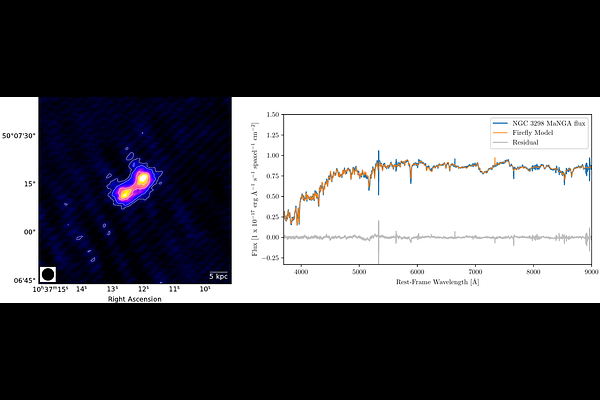Extreme AGN feedback in the fossil galaxy group SDSSTG 4436

Extreme AGN feedback in the fossil galaxy group SDSSTG 4436
D. Eckert, F. Gastaldello, L. Lovisari, S. McGee, T. Pasini, M. Brienza, K. Kolokythas, E. O'Sullivan, A. Simionescu, M. Sun, M. Ayromlou, M. A. Bourne, Y. Chen, W. Cui, S. Ettori, A. Finoguenov, G. Gozaliasl, R. Kale, F. Mernier, B. D. Oppenheimer, G. Schellenberger, R. Seppi, E. Tempel
AbstractSupermassive black hole feedback is the currently favoured mechanism to regulate the star formation rate of galaxies and prevent the formation of ultra-massive galaxies ($M_\star>10^{12}M_\odot$). However, the mechanism through which the outflowing energy is transferred to the surrounding medium strongly varies from one galaxy evolution model to another, such that a unified model for AGN feedback does not currently exist. The hot atmospheres of galaxy groups are highly sensitive laboratories of the feedback process, as the injected black hole energy is comparable to the binding energy of halo gas particles. Here we report multi-wavelength observations of the fossil galaxy group SDSSTG 4436. The hot atmosphere of this system exhibits a highly relaxed morphology centred on the giant elliptical galaxy NGC~3298. The X-ray emission from the system features a compact core ($<$10 kpc) and a steep increase in the entropy and cooling time of the gas, with the cooling time reaching the age of the Universe $\sim15$ kpc from the centre of the galaxy. The observed entropy profile implies a total injected energy of $\sim1.5\times10^{61}$ ergs, which given the high level of relaxation could not have been injected by a recent merging event. Star formation in the central galaxy NGC~3298 is strongly quenched and its stellar population is very old ($\sim$10.6 Gyr). The currently detected radio jets have low power and are confined within the central compact core. All the available evidence implies that this system was affected by giant AGN outbursts which excessively heated the neighbouring gas and prevented the formation of a self-regulated feedback cycle. Our findings imply that AGN outbursts can be energetic enough to unbind gas particles and lead to the disruption of cool cores.